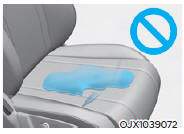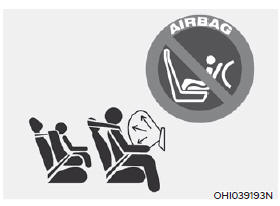Hyundai Tucson: Occupant Classification System (OCS)

Your vehicle is equipped with an Occupant Classification System (OCS) in the front passenger's seat.
Main components of the Occupant Classification System
- A detection device located within the front passenger seat cushion.
- Electronic system to determine whether the passenger air bag systems should be activated or deactivated.
- An indicator light located on the instrument panel which illuminates the words "PASSENGER AIR BAG OFF" indicating the front passenger air bag system is deactivated.
- The instrument panel air bag indicator light is interconnected with the OCS.
The OCS is designed to help detect the presence of a properly-seated front passenger and determine if the passenger's front air bag should be enabled (may inflate) or not.
The purpose is to help reduce the risk of injury or death from an inflating air bag to certain front passenger seat occupants, such as children, by requiring the air bag to be automatically turned OFF.
For example, if a child restraint of the type specified in the regulations is on the seat, the occupant classification sensor can detect it and cause the air bag to turn OFF.
Front passenger seat adult occupants who are properly seated and wearing the seat belt properly, should not cause the passenger air bag to be automatically turned OFF. For smaller adults it may turn OFF, however, if the occupant does not sit in the seat properly (for example, by not sitting upright, by sitting on the edge of the seat, or by otherwise being out of position), this could cause the sensor to turn the air bag OFF.
You will find the "PASSENGER AIR BAG OFF" indicator on the overhead console panel. This system detects the conditions 1-4 in the following table and activates or deactivates the front passenger air bag based on these conditions.
Always be sure that you and all vehicle occupants are seated properly and wearing the seat belt properly for the most effective protection by the air bag and the seat belt.
The OCS may not function properly if the passenger takes actions which can affect the classification system. These include:
- Failing to sit in an upright position.
- Leaning against the door or center console.
- Sitting towards the sides of the front of the seat.
- Putting their legs on the dashboard or resting them on other locations which reduce the passenger weight on the front seat.
- Wearing the seat belt improperly.
- Reclining the seatback.
- Wearing thick clothes like ski wear or hip protection wear.
- Putting an additional thick cushion on the seat.
- Putting electrical devices (e.g.notebook, satellite radio) on the seat with inverter charging.
Condition and operation in the front passenger Occupant Classification System

*1 : The system judges a person of adult size as an adult. When a smaller adult sits in the front passenger seat, the system may recognize him/her as a child depending on his/her physique and posture.
*2 : Do not allow children to ride in the front passenger seat. When a larger child who has outgrown a child restraint system sits in the front passenger seat, the system may recognize him/her as an adult depending upon his/her physique or sitting position.
*3 : Never install a child restraint system on the front passenger seat.
*4 : The PASSENGER AIR BAG "OFF" indicator may turn on or off when a child above 12 months to 12 years old (with or without child restraint system) sits in the front passenger seat. This is a normal condition.
WARNING
Riding in an improper position or placing weight on the front passenger's seat when it is unoccupied by a passenger adversely affects the OCS. To reduce the risk of serious injury or death:
-
 NEVER put a heavy
load in the front seat or seatback
pocket, or hang any items on the front passenger
seat.
NEVER put a heavy
load in the front seat or seatback
pocket, or hang any items on the front passenger
seat. -
 NEVER place your
feet on the front passenger
seatback.
NEVER place your
feet on the front passenger
seatback. -
 NEVER sit with your
hips shifted towards the front of
the seat.
NEVER sit with your
hips shifted towards the front of
the seat. -
 NEVER ride with the
seatback reclined when the
vehicle is moving.
NEVER ride with the
seatback reclined when the
vehicle is moving. -
 NEVER place your
feet or legs on the dashboard.
NEVER place your
feet or legs on the dashboard. -
 NEVER lean on the
door or center console or sit on
one side of the front passenger seat.
NEVER lean on the
door or center console or sit on
one side of the front passenger seat. -
 Do not sit on the
passenger seat wearing heavily
padded clothes such as ski wear and hip protector.
Do not sit on the
passenger seat wearing heavily
padded clothes such as ski wear and hip protector. -
 Do not use car seat
accessories such as thick blankets
and cushions which cover up the car seat surface.
Do not use car seat
accessories such as thick blankets
and cushions which cover up the car seat surface. -
 Do not place
electronic devices such as laptops, DVD
player, or conductive materials such as water bottles
on the passenger seat.
Do not place
electronic devices such as laptops, DVD
player, or conductive materials such as water bottles
on the passenger seat. - Do not use electronic devices such as laptops and satellite radios which use inverter chargers.
-
 If large quantity
of liquid has been spilled on the
passenger seat, the air bag warning light may
illuminate or malfunction. Therefore, make sure the seat has been completely
dried before driving the vehicle.
If large quantity
of liquid has been spilled on the
passenger seat, the air bag warning light may
illuminate or malfunction. Therefore, make sure the seat has been completely
dried before driving the vehicle. - Do not place sharp objects on the front passenger seat. These may damage the occupant detection system, if they puncture the seat cushion.
- Do not place any items under the front passenger seat.
- When changing or replacing the seat or seat cover, use original
items only.
The OCS has been developed based on using original HYUNDAI car seats only.
Altering or changing the authentic parts may result in system malfunction and increase risk of injury when in collision. Any of the above could interfere with the proper operation of the OCS sensor thereby increasing the risk of an injury in an accident.
Proper seated position for OCS

If the "PASSENGER AIR BAG OFF" indicator is on when an adult is seated in the front passenger seat, place the Engine Start/Stop button in the OFF position and ask the passenger to sit properly (sitting upright with the seat back in an upright position, centered on the seat cushion with their seat belt on, legs comfortably extended and their feet on the floor). Restart the engine and have the person remain in that position.
This will allow the system to detect the person and to enable the passenger air bag. If the "PASSENGER AIR BAG OFF" indicator is still on, ask the passenger to move to the rear seat.
WARNING
NEVER allow an adult passenger to ride in the front passenger seat when the "PASSENGER AIR BAG OFF" indicator is illuminated. During a collision, the air bag will not inflate if the indicator is illuminated. Have your passenger reposition themselves in the seat. If the "PASSENGER AIR BAG OFF" indicator remains illuminated after the passenger repositions themselves properly and the vehicle is restarted, have the passenger move to the rear seat because the air bag will not inflate.
NOTICE
The "PASSENGER AIR BAG OFF" indicator generally illuminates for approximately 4 seconds after the Engine Start/Stop button is in the ON or START position. But, if the Engine START/STOP button is pressed to the ON or START position within 3 minutes after the engine is turned OFF, the indicator does not illuminate. If the front passenger seat is occupied, the OCS will then classify the front passenger after several more seconds.
Do not install a Child Restraint System on the Front Passenger's Seat

Even though your vehicle is equipped with the OCS, never install a child restraint in the front passenger's seat.
An inflating air bag can forcefully strike a child or child restraint resulting in serious or fatal injury.
WARNING
NEVER use a rearward facing Child Restraint on a seat protected by an ACTIVE AIRBAG in front of it, DEATH or SERIOUS INJURY to the CHILD can occur.
READ NEXT:
 Why didn't my air bag go off in a
collision?
Why didn't my air bag go off in a
collision?
There are certain types of accidents in
which the air bag would not be expected
to provide additional protection. These
include rear impacts, second or third
collisions in multiple impact accidents,
as well as low speed impacts. Damage to
the v
 SRS care
SRS care
The SRS is virtually maintenance-free
and there are no parts you can safely
service by yourself. If the SRS air bag
warning light does not illuminate when
the Engine Start/Stop button is in the
ON position, or continuously remains
on, we recomm
SEE MORE:
 Vehicle settings (infotainment system)
Vehicle settings (infotainment system)
Vehicle Settings in the infotainment
system provides user options for a
variety of settings including door lock/
unlock features, convenience features,
driver assistance settings, etc.
Vehicle Settings menu
Driver Assistance
Clus
 How does the air bags system operate?
How does the air bags system operate?
The SRS consists of the following
components:
Driver's front air bag module
Passenger's front air bag module
Side air bag modules
Curtain air bag modules
Retractor pre-tensioner
Air bag warning light
SRS contr
Information
- Home
- Hyundai Tucson - Fourth generation (NX4) - (2020-2023) - Owner's Manual
- Hyundai Tucson - Fourth generation (NX4) - (2020-2023) - Workshop Manual